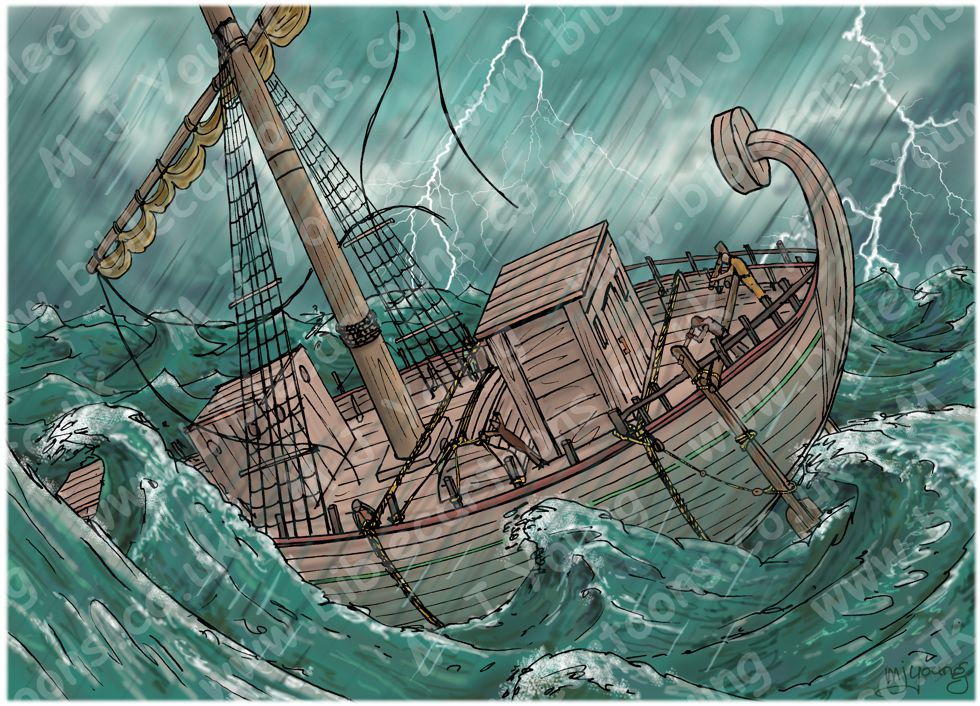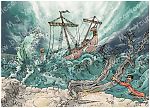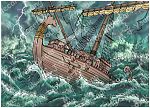Bible Cartoon: Acts 27 - Sea storm - Scene 03 - Lifeboat secured
Click on Add to cart button below shopping cart.
Purchased Bible Cartoons do not have watermarks. Links to Cartoons provided on email once purchase is completed.Bible Book: Acts
Bible Book Code: 4402701601
Scene no: 3 of 5
Bible Reference & Cartoon Description
Acts 27:16-17 (ANIV)
16 As we passed to the lee of a small island called Cauda, we were hardly able to make the lifeboat secure. 17 When the men had hoisted it aboard, they passed ropes under the ship itself to hold it together. Fearing that they would run aground on the sand-bars of Syrtis, they lowered the sea anchor and let the ship be driven along.
DRAWING NOTES:
TIME OF DAY:
Unspecified in the Bible narrative. It could be day or night… I have set this scene in the day.
LIGHTING NOTES:
The hurricane is blotting out the sun, so only vague sunshine is illuminating this scene. The lightning also adds some light.
CHARACTERS PRESENT:
Various sailors on the ship.
RESEARCH/ADDITIONAL NOTES:
This scene shows the sailors having hauled the lifeboat (which was being towed behind the ship) on board, and are rope tying it to the mid deck.
Notice that the rigging ropes have broken in the high winds and are whipping around in the air!
Verse 17 informs us that…“they passed ropes under the ship itself to hold it together.” This operation, technically known as “frapping,” consisted of carrying a strong cable or rope several times round the ship, thus reinforcing it, so as to keep the planks from “starting”, or opening up, which would cause the ship to take on water.
There seems to be some debate about the end of verse 17, where the ANIV, NLT, et al translates the Greek term skeûos as “sea anchor”. In other Bible versions that Greek word is translated as “gear” (ESV, AMP, et al). In the KJV the term “strake sail” is used, which means to lower or take down the mast, or the yards to which the sails were attached.
the Greek term skeûos, in the Blue Letter Bible is translated as “a vessel, an implement, domestic gear (plural), the tackle and armament of vessels, used specifically of sails and ropes.” In this sense it could refer to either the crew taking down the sail yardarm, and /or the entire mast, and or deploying the sea anchor(s).
What is a sea anchor? What does it do?
A sea anchor (also known as a drift anchor, drift sock, para-anchor or boat brake) is a device used to slow a ship down, or else to stabilize it, in heavy weather. Anything that can act as a source of drag in the water can act as a sea anchor. It could be as simple as a long line of rope, paid out into the water, which doesn’t provide much drag but acts to keep the vessel facing into the wind. Early sea anchors were often improvised from spare parts found onboard a ship. A sail, weighed down with an anchor chain or other heavy object, would also work as an improvised sea anchor.
The sea anchor doesn’t attach the ship to the seabed, rather it is designed to increases the drag through the water and thus act as a brake. When attached to the stern (back) of a vessel, a sea anchor can prevent it from turning broadside to the waves, which might cause stress on the hull, damage the hull, and even capsize the ship.





